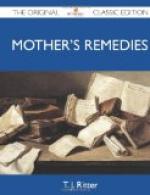Comparative danger.—A wound of the hand after a delay of three weeks is as dangerous as a bite on the head exposed only a few days. There is always a possibility of an accumulative action and extension of the virus along the nerve trunk to the central nervous system during the interval of exposure, and this should be always borne in mind. It is stated by authority that the virus is not transmitted by the bite of a rabid animal until two days previous to the appearance of the first symptoms. It is with some difficulty that a decision is reached in advising patients who are bitten to take treatment early in the course of the disease. The symptoms are often so very obscure and slight that they are not recognized. If a dog which is not naturally vicious suddenly bites without any cause it should be tied securely and watched for seven days; and should it develop symptoms of the disease during this period the bite should be considered dangerous.
Immediate treatment of the wound.—A temporary measure is the cauterization of the wound; do not neglect this because a few hours have passed since the person was bitten, for wounds may be cauterized with advantage even after two or three days have elapsed. Of course the earlier it is done the better. If they are thoroughly laid open and scrubbed it is more effective. Nitric acid used freely is the best method to use. Wash the wound freely with boiled water after the acid has been applied; ninety-five per cent carbolic acid may be used if nitric acid cannot be obtained.
If carbolic acid is used it is necessary that it be washed from the wound by the free use of absolute alcohol, followed by boiled water and a dressing of bichloride of 1-7000. This prevents the ulceration of the wound by the carbolic acid. Cauterization thoroughly done destroys a part of the inoculated virus. Thorough cauterization is especially necessary with large wounds in which large quantities of the virus is inoculated.
When to send patients to an Institute.—Send them immediately, if there is good reason to believe the animal had rabies. It is not wise to wait until the animal dies; it is very important that treatment is begun as soon as possible, especially in severe bites.
What to send for examination.—The entire head may be sent by express, or better, the health officer should bring it in person. This saves time and relieves anxiety; or a portion of the brain may be removed under thoroughly clean conditions and placed in a sterilized twenty per cent solution of glycerin and water. In this way the virus retains its virulence and putrefaction is diminished. The first method is the best, taking the head directly. The head after it reaches the laboratory is examined microscopically for “negri bodies,” and if there is no contamination the microscopic findings are verified by animal inoculations. The presence of negri bodies in a specimen is of great value owing to the rapidity with which a diagnosis can be made. In one case a positive diagnosis was reported within twenty minutes after the specimen entered the laboratory and within the next hour and a half the patient bitten by the dog the same day had begun her course of protective injections and was saved.




